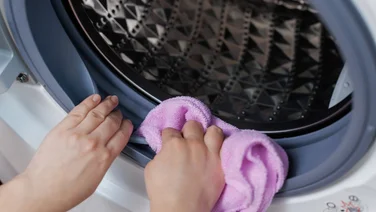To help us provide you with free impartial advice, we may earn a commission if you buy through links on our site. Learn more

Modern irons come with all sorts of clever features to keep them running smoothly, including anti-scale, anti-calc and self-cleaning modes. But even with these inclusions, you still need to take time to regularly descale your iron to keep it in tip-top condition. Even the best steam irons can fall foul of the dreaded limescale.
“Pesky limescale can leave unwanted marks on your garments, so it’s important to regularly descale your iron to keep your clothing in good nick,” explains Hannah Hamer, assistant marketing manager at Russell Hobbs. “If you live in a hard water area and fill up your iron directly from the tap, you risk harmful limescale build-up in your appliance over time, which can shorten the life and performance of the iron and create less steam.”
Limescale refers to the deposits of calcium particles found in hard water, which builds up in appliances, on sinks and in bathrooms. It can be a nightmare to remove if allowed to accumulate, so the advice is to ensure appliances and surfaces are cleaned of it on a regular basis.
READ NEXT: Best steam generator irons
How to look after your iron every time you use it
“Here at Russell Hobbs, we recommend using distilled water instead of tap water in your iron, especially if you live in a hard water area,” says Hannah. “We advise against using a descaling solution, since it can destroy the anti-scale agent that already exists within the appliance.” In addition, when using your iron, Hannah advises that it’s used at the recommended temperature, and once you’ve tackled your pile of ironing, you allow the iron to cool down completely and drain the water from the reservoir after each use. It’s important to wipe over your iron with a damp cloth, too, to stop any drops of water from “drying” on the iron’s surface. “Make sure you don’t miss the soleplate, either – you can remove any spots from it by using a small amount of vinegar on a soft, dry cloth,” she adds.
Signs that it’s time to descale your iron
There are some obvious signs that indicate it’s time to descale your iron. A visual cue is the sight of scale inside the water reservoir, as well as water leaking from beneath the soleplate along with an uneven flow of steam. Also, if your iron is dragging over clothes it means that the soleplate has residue on it that’s preventing it from gliding smoothly. Finally, if your iron is really clogged up, you might find it spitting bits of limescale or rusty brown water out onto your clothes.
READ NEXT: Best steam irons
How to descale your iron
There are various ways to successfully descale your iron and remove any lingering traces of limescale from different parts of the iron. Let’s look at some of them below.
1. Use your iron’s Self Clean feature
“While every iron will have its own descaling manual that’s appliance-specific, descaling an iron is a pretty simple process,” explains Hannah. “Start by filling the water tank to the maximum mark, then set the temperature control to ‘max’ and the steam control to ‘no steam’. Place the iron on its heel, put the plug into the power socket and wait until the light on the iron turns off. Next, hold the iron over a basin or large bowl with the soleplate facing down, and hold down the Self Clean button, gently moving the iron to and fro. You’ll start to see water and steam wash scale and dust through the soleplate into the sink or bowl. Once the water tank is empty, release the Self Clean button, unplug the iron, and stand it on its heel to cool. We’d recommend running this function each month to thoroughly clean the system and minimise limescale build-up.”Linda Binsley, customer relations manager at Tefal, offers similar advice. “The anti-calc system in our irons and the cleaning process (which sees particles flushed out of the iron) are both very effective, particularly if carried out regularly.” Tefal’s findings suggest the majority don’t do this regularly enough; “we’d recommend once a month,” she adds. “In addition, those in hard water areas should do this more frequently, and can also use a mix of 50% untreated tap water and 50% distilled water.” Like Russell Hobbs, Tefal would never recommend using “descaling solutions”, since these can cause irreparable damage to the iron. “We also recommend regularly wiping down your iron with a soft, damp cloth to remove fluff, dust and clothing fibres; these can be sucked up by the iron when in use and later spat out onto clothing, which can look like bits of scale. You should also avoid storing your iron in an airing cupboard for the same reason.” She also adds that you can gently vacuum the holes of the soleplate of your iron to remove any dirt and dust.
2. Clean the iron reservoir with vinegar
Limescale can clog up the steam function of your iron, leading to marks on darker fabrics. The humble bottle of white vinegar is your friend here, helping you to clean your iron’s reservoir for not much money at all.

Make sure your iron is cool and that the water tank is completely empty. Depending on the degree of limescale, fill the reservoir a third of the way up with either neat white vinegar or a half-and-half solution of white vinegar and distilled, or deionized, water. Stand the iron on its heel on a piece of old fabric and set it to steam until the tank is empty. Refill the tank with water and steam again until the tank has been emptied at least twice through to get rid of any lingering smell of vinegar.
3. Clean an iron with vinegar
You can also use vinegar to clean your iron’s soleplate. We’d advise using a microfibre cloth, dipped into a mixture of half white vinegar, half distilled water to gently wipe over the plate to remove limescale. Once clean, refill the iron’s water tank with distilled water, plug in and set to steam on an old piece of thicker fabric (such as a towel) for at least five minutes to remove any smell of vinegar. If your soleplate is badly burnt, you can use white vinegar undiluted to clean it. Soak an old towel in the vinegar and lay the iron flat on it for at least half an hour. Once this time has elapsed, it should be easy to wipe off any remaining dirt and residue.

4. Clean the steam holes
Descaling can’t always reach right into the actual steam holes, leaving small amounts of limescale inside that can clog up the steam function. The quickest and simplest way to clean them is with cotton buds dipped in white vinegar. Simply rub the steam holes until they’re clean, and then wipe clean with another cotton bud dipped in distilled water.
READ NEXT: Best clothes steamers
5. Clean with tumble dryer sheets
This method requires a little care. Switch your iron on, but at its lowest temperature. Now take a clean tumble dryer sheet and very carefully rub the iron’s soleplate. As the sheet warms up, the dirt will start to become loose. Once you’ve removed all the dirt, turn up the iron’s heat to high and iron over an old piece of fabric to remove any residue from the dryer sheet.
6. Clean the iron with lemon juice
Similar to using vinegar, lemon juice is also a great option for descaling your iron. Start with a mixture that’s half lemon juice, half distilled water and pour this into your iron’s water reservoir. Turn your iron on to a setting that’s hot enough to create steam and then leave it to heat up and soak for around 15 minutes. Now iron a clean cloth using the steam function until the water reservoir is empty. Let the iron cool down before rinsing out the reservoir with clean distilled water. Pour out, fill with more distilled water and run with the steam function again. Repeat one more time to ensure you’ve removed any smell of lemon.






